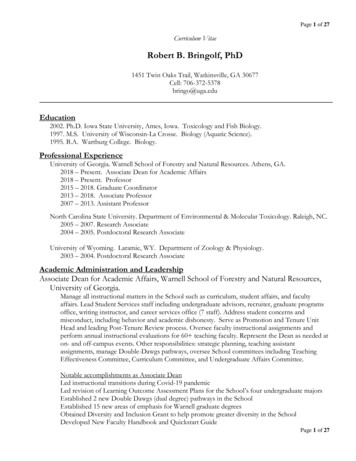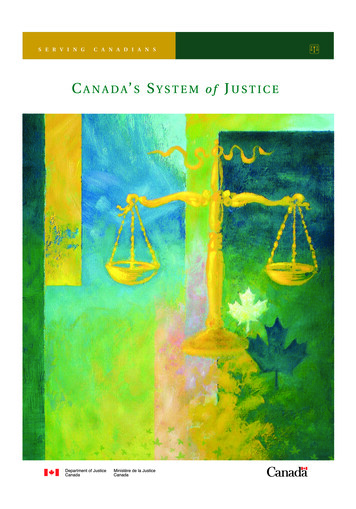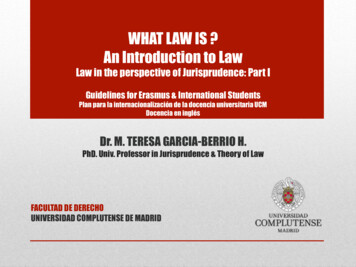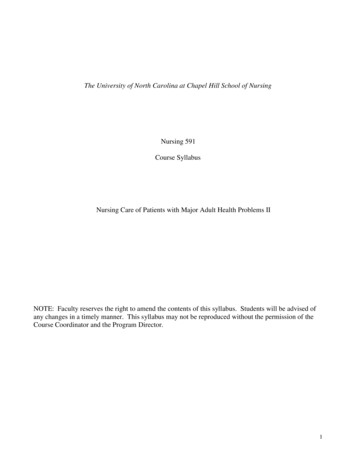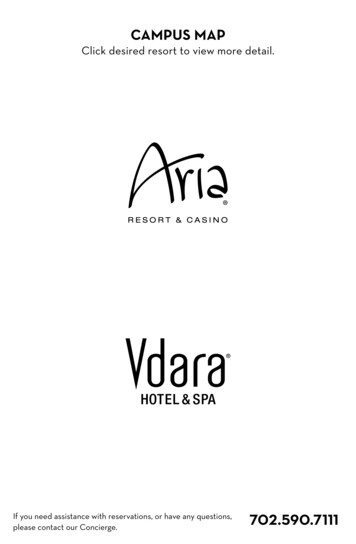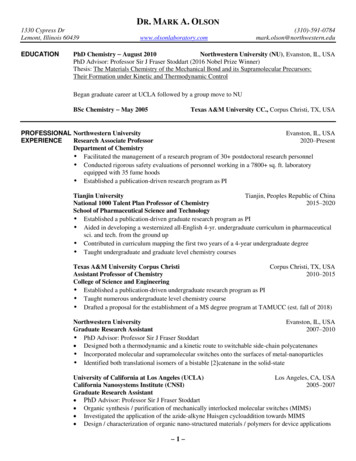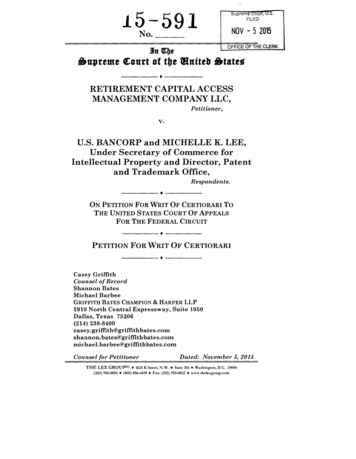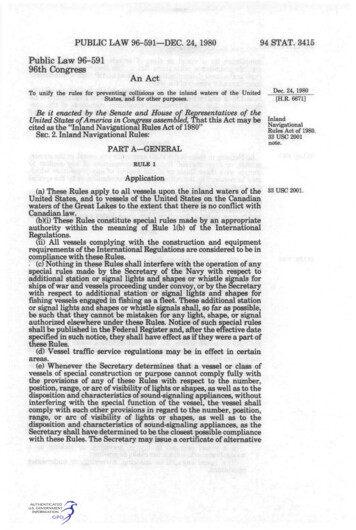
Transcription
PUBLIC LAW 96-591—DEC. 24, 198094 STAT. 3415Public Law 96-59196th CongressAn ActTo unify the rules for preventing collisions on the inland waters of the UnitedStates, and for other purposes.Uec. 4, lt oO[H.R. 6671]Be it enacted by the Senate and House of Representatives of theUnited States ofAmerica in Congress assembled, That this Act may be inlandcited as the "Inland Navigational Rules Act of 1980"R E A J ? of 1980SEC. 2. Inland Navigational Rules:33 use 2001PART A—GENERALnote.RULE 1Application(a) These Rules apply to all vessels upon the inland waters of the 33 USC 2001.United States, and to vessels of the United States on the Canadianwaters of the Great Lakes to the extent that there is no conflict withCanadian law.03)(i) These Rules constitute special rules made by an appropriateauthority within the meaning of Rule 1(h) of the InternationalReflations.(ii) All vessels complying with the construction and equipmentrequirements of the International Regulations are considered to be incompliance with these Rules. (c) Nothing in these Rules shall interfere with the operation of anyspecial rules made by the Secretary of the Navy with respect toadditional station or signal lights and shapes or whistle signals forships of war and vessels proceeding under convoy, or by the Secretarywith respect to additional station or signal lights and shapes forfishing vessels engaged in fishing as a fleet. These additional stationor signal lights and shapes or whistle signals shall, so far as possible,be such that they cannot be mistaken for any light, shape, or signalauthorized elsewhere under these Rules. Notice of such special rulesshall be published in the Federal Register and, after the effective datespecified in such notice, they shall have effect as if they were a part ofthese Rules.(d) Vessel traffic service regulations may be in effect in certainareas.(e) Whenever the Secretary determines that a vessel or class ofvessels of special construction or purpose cannot comply fully withthe provisions of any of these Rules with respect to the number,position, range, or arc of visibility of lights or shapes, as well as to thedisposition and characteristics of sound-signaling appliances, withoutinterfering with the special function of the vessel, the vessel shallcomply with such other provisions in regard to the number, position,range, or arc of visibility of lights or shapes, as well as to thedisposition and characteristics of sound-signaling appliances, as theSecretary shall have determined to be the closest possible compliancewith these Rules. The Secretary may issue a certificate of alternative
94 STAT. 3416PUBLIC LAW 96-591—DEC. 24, 1980compliance for a vessel or class of vessels specifying the closestpossible compliance with these Rules. The Secretary of the Navyshall make these determinations and issue certificates of alternativecompliance for vessels of the Navy.(f) The Secretary may accept a certificate of alternative complianceissued by a contracting party to the International Regulations if hedetermines that the alternative compliance standards of the contracting party are substantially the same as those of the UnitedStates.RULE 2Responsibility33 use 2002.( ) Nothing in these Rules shall exonerate any vessel, or the owner,master, or crew thereof, from the consequences of any neglect tocomply with these Rules or of the neglect of any precaution whichmay be required by the ordinary practice of seamen, or by the specialcircumstances of the case.(b) In construing and complying with these Rules due regard shallbe had to all dangers of navigation and collision and to any specialcircumstances, including the limitations of the vessels involved,which may make a departure from these Rules necessary to avoidimmediate danger.RULE 3General Definitions33 use 2003.PQJ. tjig purpose of these Rules and this Act, except where thecontext otherwise requires:(a) The word "vessel" includes every description of water craft,including nondisplacement craft and seaplanes, used or capable ofbeing used as a means of transportation on water;(b) The term "power-driven vessel" means any vessel propelled bymachinery;(c) The term "sailing vessel" means any vessel under sail providedthat propelling machinery, if fitted, is not being used;(d) The term "vessel engaged in fishing" means any vesselfishing with nets, lines, trawls, or other fishing apparatus whichrestricts maneuverability, but does not include a vessel fishing withtrolling lines or other fishing apparatus which do not restrictmaneuverability;(e) The word "seaplane" includes any aircraft designed to maneuver on the water;(f) The term "vessel not under command" means a vessel whichthrough some exceptional circumstance is unable to maneuver asrequired by these Rules and is therefore unable to keep out of the wayof another vessel;(g) The term "vessel restricted in her ability to maneuver" means avessel which from the nature of her work is restricted in her ability tomaneuver as required by these Rules and is therefore unable to keepout of the way of another vessel; vessels restricted in their ability tomaneuver include, but are not limited to:(i) a vessel engaged in laying, servicing, or picking up anavigation mark, submarine cable, or pipeline;(ii) a vessel engaged in dredging, surveying, or underwateroperations;
PUBLIC LAW 96-591—DEC. 24, 198094 STAT. 3417(iii) a vessel engaged in replenishment or transferring persons,provisions, or cargo while underway;(iv) a vessel engaged in the launching or recovery of aircraft;(v) a vessel engaged in minesweeping operations; and(vi) a vessel engaged in a towing operation such as severelyrestricts the towing vessel and her tow in their ability to deviatefrom their course.(h) The word "underway" means that a vessel is not at anchor, ormade fast to the shore, or aground;(i) The words "length" and "breadth" of a vessel mean her lengthoverall and greatest breadth;(j) Vessels shall be deemed to be in sight of one another only whenone can be observed visually from the other;(k) The term "restricted visibility" means any condition in whichvisibility is restricted by fog, mist, falling snow, heavy rainstorms,sandstorms, or any other similar causes;(1) "Western Rivers" means the Mississippi River, its tributaries.South Pass, and Southwest Pass, to the navigational demarcationlines dividing the high seas from harbors, rivers, and other inlandwaters of the United States, and the Port Allen-Morgan City Alternate Route, and that part of the Atchafalaya River above its junctionwith the Port Allen-Morgan City Alternate Route including the OldRiver and the Red River;(m) "Great Lakes" means the Great Lakes and their connectingand tributary waters including the Calumet River as far as theThomas J. O'Brien Lock and Controlling Works (between mile 326and 327), the Chicago River as far as the east side of the AshlandAvenue Bridge (between mile 321 and 322), and the Saint LawrenceRiver as far east as the lower exit of Saint Lambert Lock;(n) "Secretary" means the Secretary of the department in whichthe Coast Guard is operating;(o) "Inland Waters" means the navigable waters of the UnitedStates shoreward of the navigational demarcation lines dividing thehigh seas from harbors, rivers, and other inland waters of the UnitedStates and the waters of the Great Lakes on the United States side ofthe International Boundary;(p) "Inland Rules" or "Rules" mean the Inland Navigational Rulesand the annexes thereto, which govern the conduct of vessels andspecify the lights, shapes, and sound signals that apply on inlandwaters; and(q) "International Regulations" means the International Regulations for Preventing Collisions at Sea, 1972, including annexes 33 USC1602currently in force for the United States." * PART B—STEERING AND SAILING RULESSUBPART I—CONDUCT OF VESSELS IN ANY CONDITION OF VISIBILITYRULE 4ApplicationRules in this subpart apply in any condition of visibility,33 USC 2004.
94 STAT. 3418PUBLIC LAW 96-591—DEC. 24, 1980RULE 5Look-out33 use 2005.Every vessel shall at all times maintain a proper look-out by sightand hearing as well as by all available means appropriate in theprevailing circumstances and conditions so as to make a fullappraisal of the situation and of the risk of collision.RULE 6Safe Speed33 use 2006.Every vessel shall at all times proceed at a safe speed so that shecan take proper and effective action to avoid collision and be stoppedwithin a distance appropriate to the prevailing circumstances andconditions.In determining a safe speed the following factors shall be amongthose taken into account:(a) By all vessels:(i) the state of visibility;(ii) the traffic density including concentration of fishing vesselsor any other vessels;(iii) the maneuverability of the vessel with special referenceto stopping distance and turning ability in the prevailingconditions;(iv) at night the presence of background light such as fromshores lights or from back scatter of her own lights;(v) the state of wind, sea, and current, and the proximity ofnavigational hazards;(vi) the draft in relation to the available depth of water.Ot)) Additionally, by vessels with operational radar:(i) the characteristics, efficiency and limitations of the radarequipment;(ii) any constraints imposed by the radar range scale in use;(iii) the effect on radar detection of the sea state, weather, andother sources of interference;(iv) the possibility that small vessels, ice and other floatingobjects may not be detected by radar at an adequate range;(v) the number, location, and movement of vessels detected byradar; and(vi) the more exact assessment of the visibility that may bepossible when radar is used to determine the range of vessels orother objects in the vicinity.RULE 7Risk of Collision33 use 2007.(a) Every vessel shall use all available means appropriate to theprevailing circumstances and conditions to determine if risk ofcollision exists. If there is any doubt such risk shall be deemed toexist.(b) Proper use shall be made of radar equipment if fitted andoperational, including long-range scanning to obtain early warning ofrisk of collision and radar plotting or equivalent systematic observation of detected objects.
PUBLIC LAW 96-591—DEC. 24, 198094 STAT. 3419(c) Assumptions shall not be made on the basis of scanty information, especially scanty radar information.(d) In determining if risk of collision exists the following considerations shall be among those taken into account:(i) such risk shall be deemed to exist if the compass bearing ofan approaching vessel does not appreciably change; and(ii) such risk may sometimes exist even when an appreciablebearing change is evident, particularly when approaching a verylarge vessel or a tow or when approaching a vessel at close range.RULE 8Action To Avoid Collision(a) Any action taken to avoid collision shall, if the circumstances of 33 use 2008.the case admit, be positive, made in ample time and with due regardto the observance of good seamanship.(b) Any alteration of course or speed to avoid collision shall, if thecircumstances of the case admit, be large enough to be readilyapparent to another vessel observing visually or by radar; a succession of Ismail alterations of course or speed should be avoided,(c) If there is sufficient sea room, alteration of course alone may bethe most effective action to avoid a close-quarters situation providedthat it is made in good time, is substantial and does not result inanother close-quarters situation.(d) Action taken to avoid collision with another vessel shall be suchas to result in passing at a safe distance. The effectiveness of theaction shall be carefully checked until the other vessel is finally pastand clear.(e) If necessary to avoid collision or allow more time to assess thesituation, a vessel shall slacken her speed or take all way off bystopping or reversing her means of propulsion.RULE 9Narrow Channels(a)(i) A vessel proceeding along the course of a narrow channel or 33 USC 2009.fairway shall keep as near to the outer limit of the channel or fairwaywhich lies on her starboard side as is safe and practicable.(ii) Notwithstanding paragraph (a)(i) and Rule 14(a), a power-drivenvessel operating in narrow channels or fairways on the Great Lakes,Western Rivers, or waters specified by the Secretary, and proceedingdownbound with a following current shall have the right-of-way overan upbound vessel, shall propose the manner and place of passage,and shall initiate the maneuvering signals prescribed by Rule 34(a)(i),as appropriate. The vessel proceeding upbound against the currentshall hold as necessary to permit safe passing.(b) A vessel of less than 20 meters in length or a sailing vessel shallnot impede the passage of a vessel that can safely navigate onlywithin a narrow channel or fairway.(c) A vessel engaged in fishing shall not impede the passage of anyother vessel navigating within a narrow channel or fairway.(d) A vessel shall not cross a narrow channel or fairway if suchcrossing impedes the passage of a vessel which can safely navigateonly within that channel or fairway. The latter vessel shall use thedanger signal prescribed in Rule 34(d) if in doubt as to the intention ofthe crossing vessel.
94 STAT. 3420PUBLIC LAW 96-591—DEC. 24, 1980(e)(i) In a narrow channel or fairway when overtaking, the vesselintending to overtake shall indicate her intention by sounding theappropriate signal prescribed in Rule 34(c) and take steps to permitsafe passing. The overtaken vessel, if in agreement, shall sound thesame signal. If in doubt she shall sound the danger signal prescribedin Rule 34(d).(ii) This Rule does not relieve the overtaking vessel of her obligation under Rule 13.(f) A vessel nearing a bend or an area of a narrow channel orfairway where other vessels may be obscured by an interveningobstruction shall navigate with particular alertness and caution andshall sound the appropriate signal prescribed in Rule 34(e).(g) Every vessel shall, if the circumstances of the case admit, avoidanchoring in a narrow channel.RULE 10Vessel Traffic Services33 use 2010.Each vessel required by regulation to participate in a vessel trafficservice shall comply with the applicable regulations.SUBPART II—CONDUCT OF VESSELS IN SIGHT OF ONE ANOTHERRULE 11Application33 use 2011.Rules in this subpart apply to vessels in sight of one another.RULE 12Sailing Vessels33 use 2012.(a) When two sailing vessels are approaching one another, so as toinvolve risk of collision, one of them shall keep out of the way of theother as follows:(i) when each has the wind on a different side, the vessel whichhas the wind on the port side shall keep out of the way of theother;(ii) when both have the wind on the same side, the vessel whichis to windward shall keep out of the way of the vessel which is toleeward; and(iii) if a vessel with the wind on the port side sees a vessel towindward and cannot determine with certainty whether theother vessel has the wind on the port or on the starboard side, sheshall keep out of the way of the other.(b) For the purpose of this Rule the windward side shall be deemedto be the side opposite to that on which the mainsail is carried or, inthe case of a square-rigged vessel, the side opposite to that on whichthe largest fore-and-aft sail is carried.RULE 13Overtaking33 use 2013.(a) Notwithstanding anything contained in Rules 4 through 18, anyvessel overtaking any other shall keep out of the way of the vesselbeing overtaken.
PUBLIC LAW 96-591—DEC. 24, 198094 STAT. 3421(b) A vessel shall be deemed to be overtaking when coming up withanother vessel from a direction more than 22,5 degrees abaft herbeam; that is, in such a position with reference to the vessel she isovertaking, that at night she would be able to see only the sternlightof that vessel but neither of her sidelights.(c) When a vessel is in any doubt as to whether she is overtakinganother, she shall assume that this is the case and act accordingly.(d) Any subsequent alteration of the bearing between the twovessels shall not make the overtaking vessel a crossing vessel withinthe meaning of these Rules or relieve her of the duty of keeping clearof the overtaken vessel until she is finally past and clear.RULE 14Head-on Situation(a) When two power-driven vessels are meeting on reciprocal or USC 2014.nearly reciprocal courses so as to involve risk of collision each shallalter her course to starboard so that each shall pass on the port side ofthe other.(b) Such a situation shall be deemed to exist when a vessel sees theother ahead or nearly ahead and by night she could see the mastheadlights of the other in a line or nearly in a line or both sidelights and byday she observes the corresponding aspect of the other vessel.(c) When a vessel is in any doubt as to whether such a situationexists she shall assume that it does exist and act accordingly.RULE 15Crossing Situation(a) When two power-driven vessels are crossing so as to involve risk 33 USC 2015.of collision, the vessel which has the other on her starboard side shallkeep out of the way and shall, if the circumstances of the case admit,avoid crossing ahead of the other vessel.(b) Notwithstanding paragraph (a), on the Great Lakes, WesternRivers, or water specified by the Secretary, a vessel crossing a rivershall keep out of the way of a power-driven vessel ascending ordescending the river.RULE 16Action by Give-Way VesselEvery vessel which is directed to keep out of the way of another 3 USC 2016.vessel shall, so far as possible, take early and substantial action tokeep well clear.RULE 17Action by Stand-on Vessel(a)(i) Where one of two vessels is to keep out of the way, the other 33 USC 2017.shall keep her course and speed.(ii) The latter vessel may, however, take action to avoid collision byher maneuver alone, as soon as it becomes apparent to her that thevessel required to keep out of the way is not taking appropriate actionin compliance with these Rules.(b) When, from any cause, the vessel required to keep her courseand speed finds herself so close that collision cannot be avoided by the
94 STAT. 3422PUBLIC LAW 96-591—DEC. 24, 1980action of the give-way vessel alone, she shall take such action as willbest aid to avoid collision.(c) A power-driven vessel which takes action in a crossing situationin accordance with subparagraph (a)(ii) of this Rule to avoid collisionwith another power-driven vessel shall, if the circumstances of thecase admit, not alter course to port for a vessel on her own port side.(d) This Rule does not relieve the give-way vessel of her obligationto keep out of the way.RULE 18Responsibilities Between Vessels33 use 2018.Except where Rules 9,10, and 13 otherwise require:(a) A power-driven vessel underway shall keep out of the way of:(i) a vessel not under command;(ii) a vessel restricted in her ability to maneuver;(iii) a vessel engaged in fishing; and(iv) a sailing vessel.(b) A sailing vessel underway shall keep out of the way of:(i) a vessel not under command;(ii) a vessel restricted in her ability to maneuver; and(iii) a vessel engaged in fishing.(c) A vessel engaged in fishing when underway shall, so far aspossible, keep out of the way of:(i) a vessel not under command; and(ii) a vessel restricted in her ability to maneuver.(d) A seaplane on the water shall, in general, keep well clear of allvessels and avoid impeding their navigation. In circumstances, however, where risk of collision exists, she shall comply with the Rules ofthis Part.SUBPART III—CONDUCT OF VESSELS IN RESTRICTED VISIBIUTYRULE 19Conduct of Vessels in Restricted Visibility33 use 2019.(a) This Rule applies to vessels not in sight of one another whennavigating in or near an area of restricted visibility.(b) Every vessel shall proceed at a safe speed adapted to theprevailing circumstances and conditions of restricted visibility. Apower-driven vessel shall have her engines ready for immediatemaneuver.(c) Every vessel shall have due regard to the prevailing circumstances and conditions of restricted visibility when complying withRules 4 through 10.(d) A vessel which detects by radar alone the presence of anothervessel shall determine if a close-quarters situation is developing orrisk of collision exists. If so, she shall take avoiding action in ampletime, provided that when such action consists of an alteration ofcourse, so far as possible the following shall be avoided:(i) an alteration of course to port for a vessel forward of thebeam, other than for a vessel being overtaken; and(ii) an alteration of course toward a vessel abeam or abaft thebeam.(e) Except where it has been determined that a risk of collision doesnot exist, every vessel which hears apparently forward of her beamthe fog signal of another vessel, or which cannot avoid a close-
PUBLIC LAW 96-591—DEC. 24, 198094 STAT. 3423quarters situation with another vessel forward of her beam, shallreduce her speed to the minimum at which she can be kept on course.She shall if necessary take all her way off and, in any event, navigatewith extreme caution until danger of collision is over.PART C—LIGHTS AND SHAPESRULE 20Application(a) Rules in this Part shall be complied with in all weathers. 33 USC 2020.(b) The Rules concerning lights shall be complied with from sunsetto sunrise, and during such times no other lights shall be exhibited,except such lights as cannot be mistaken for the lights specified inthese Rules or do not impair their visibility or distinctive character,or interfere with the keeping of a proper lookout.(c) The lights prescribed by these Rules shall, if carried, also beexhibited from sunrise to sunset in restricted visibility and may beexhibited in all other circumstances when it is deemed necessary.(d) The Rules concerning shapes shall be complied with by day.(e) The lights and shapes specified in these Rules shall comply withthe provisions of Annex I of these Rules.RULE 21Definitions(a) "Masthead light" means a white light placed over the fore and 33 USC 2021.aft centerline of the vessel showing an unbroken light over an arc ofthe horizon of 225 degrees and so fixed as to show the light from rightahead to 22,5 degrees abaft the beam on either side of the vessel,ex;cept that on a vessel of less than 12 meters in length the mastheadlight shall be placed as nearly as practicable to the fore and aftcenterline of the vessel.(b) "Sidelights" mean a green light on the starboard side and a redlight on the port side each showing an unbroken light over an arc ofthe horizon of 112.5 degrees and so fixed as to show the light fromright ahead to 22.5 degrees abaft the beam on its respective side. On avessel of less than 20 meters in length the side lights may becombined in one lantern carried on the fore and aft centerline of thevessel, except that on a vessel of less than 12 meters in length thesidelights when combined in one lantern shall be placed as nearly aspracticable to the fore and aft centerline of the vessel.(c) "Sternlight" means a white light placed as nearly as practicableat the stern showing an unbroken light over an arc of the horizon of135 degrees and so fixed as to show the light 67.5 degrees from rightaft on each side of the vessel.(d) "Towing light" means a yellow light having the same characteristics as the "sternlight" defined in paragraph (c) of this Rule.(e) "All-round light" means a light showing an unbroken light overan arc of the horizon of 360 degrees.(f) "Flashing light" means a light flashing at regular intervals at afrequency of 120 flashes or more per minute.(g) "Special flashing light" means a yellow light flashing at regularintervals at a frequency of 50 to 70 flashes per minute, placed as farforward and as nearly as practicable on the fore and aft centerline ofthe tow and showing an unbroken light over an arc of the horizon of
94 STAT. 3424PUBLIC LAW 96-591—DEC. 24, 1980not less than 180 degrees nor more than 225 degrees and so fixed as toshow the light from right ahead to abeam and no more than 22.5degrees abaft the beam on either side of the vessel.RULE 22Visibility of Lights33 use 2022.The lights prescribed in these Rules shall have an intensity asspecified in Annex I to these Rules, so as to be visible at the followingminimum ranges:(a) In a vessel of 50 meters or more in length:a masthead light, 6 miles;a sidelight, 3 miles;a sternlight, 3 miles;a towing light, 3 miles;a white, red, green or yellow all-round light, 3 miles; anda special flashing light, 2 miles.(b) In a vessel of 12 meters or more in length but less than 50 metersin length:a masthead light, 5 miles; except that where the length of thevessel is less than 20 meters, 3 miles;a sidelight, 2 miles;a sternlight, 2 miles;a towing light, 2 miles;a white, red, green or yellow all-round light, 2 miles; anda special flashing light, 2 miles.(c) In a vessel of less than 12 meters in length:a masthead light, 2 miles;a sidelight, 1 mile;a sternlight, 2 miles;a towing light, 2 miles;a white, red, green or yellow all-round light, 2 miles; anda special fleishing light, 2 miles.(d) In an inconspicuous, partly submerged vessel or object beingtowed:a white all-round light, 3 miles.RULE 23Power-Driven Vessels Underway33 use 2023.(a) A power-driven vessel underway shall exhibit:(i) a masthead light forward; except that a vessel of less than 20meters in length need not exhibit this light forward of amidshipsbut shall exhibit it as far forward as is practicable;(ii) a second masthead light abaft of and higher than theforward one; except that a vessel of less than 50 meters in lengthshall not be obliged to exhibit such light but may do so;(iii) sidelights; and(iv) a sternlight.Ot)) An air-cushion vessel when operating in the nondisplacementmode shall, in addition to the lights prescribed in paragraph (a) of thisRule, exhibit an all-round flashing yellow light where it can best beseen.(c) A power-driven vessel of less than 12 meters in length may, inlieu of the lights prescribed in paragraph (a) of this Rule, exhibit anall-round white light and sidelights.
PUBLIC LAW 96-591—DEC. 24, 198094 STAT. 3425(d) A power-driven vessel when operating on the Great Lakes maycarry an all-round white light in lieu of the second masthead lightand sternlight prescribed in paragraph (a) of this Rule. The light shallbe carried in the position of the second masthead light and be visibleat the same minimum range.RULE 24Towing and Pushing(a) A power-driven vessel when towing astern shall exhibit:33 USC 2024.(i) instead of the light prescribed either in Rule 23 (a)(i) or23(a)(ii), two masthead lights in a vertical line. When the lengthof the tow, measuring from the stern of the towing vessel to theafter end of the tow exceeds 200 meters, three such lights in avertical line;(ii) sidelights;(iii) a sternlight;(iv) a towing light in a vertical line above the sternlight; and(v) when the length of the tow exceeds 200 meters, a diamondshape where it can best be seen.Ot)) When a pushing vessel and a vessel being pushed ahead arerigidly connected in a composite unit they shall be regarded as apower-driven vessel and exhibit the lights prescribed in Rule 23.(c) A power-driven vessel when pushing ahead or towing alongside,except as required by paragraphs (b) and (i) of this Rule, shall exhibit:(i) instead of the light prescribed either in Rule 23(a)(i) or23(a)(ii), two masthead lights in a vertical line;(ii) sidelights; and(iii) two towing lights in a vertical line.(d) A power-driven vessel to which paragraphs (a) or (c) of this Ruleapply shall also comply with Rule 23(aXi) and 23(aXii).(e) A vessel or object other than those referred to in paragraph (g) ofthis Rule being towed shall exhibit:(i) sidelights;(ii) a sternlight; and(iii) when the length of the tow exceeds 200 meters, a diamondshape where it can best be seen.if) Provided that any number of vessels being towed alongside orpushed in a group shall be lighted as one vessel:(i) a vessel being pushed ahead, not being part of a compositeunit, shall exhibit at the forward end sidelights, and a specialflashing light; and(ii) a vessel being towed alongside shall exhibit a sternlight andat the forward end sidelights,(g) An inconspicuous, partly submerged vessel or object being towedshall exhibit:(i) if it is less than 25 meters in breadth, one all-round whitelight at or near each end;(ii) if it is 25 meters or more in breadth, four all-round whitelights to mark its length and breadth;(iii) if it exceeds 100 meters in length, additional all-roundwhite lights between the lights prescribed in subparagraphs (i)and (ii) so that the distance between the lights shall not exceed100 meters: Provided, That any vessels or objects being towedalongside each other shall be lighted as one vessel or object;(iv) a diamond shape at or near the aftermost extremity of thelast vessel or object being towed; and
94 STAT. 3426PUBLIC LAW 96-591—DEC. 24, 1980(v) the towing vessel may direct a searchlight in the directionof the tow to indicate its presence to an approaching vessel.(h) Where from any sufficient cause it is impracticable for a vesselor object being towed to exhibit the lights prescribed in paragraph (e)or (g) of this Rule, all possible measures shall be taken to light thevessel or object towed or at least to indicate the presence of theunlighted vessel or object.(i) Notwithstanding paragraph (c), on the Western Rivers and onwaters specified by the Secretary, a power-driven vessel when pushing ahead or towing alongside, except as paragraph (b) applies, shallexhibit:(i) sidelights; and(ii) two towing lights in a vertical line.(j) Where from any sufficient cause it is impracticable for a vesselnot normally engaged in towing operations to display the lightsprescribed by paragraph (a), (c) or (i) of this Rule, such vessel shall notbe required to exhibit those lights when engaged in towing anothervessel in distress or otherwise in need of assistance. All possiblemeas
Every vessel which is directed to keep out of the way of another 3 USC 2016. vessel shall, so far as possible, take early and substantial action to keep well clear. RULE 17 Action by Stand-on Vessel (a)(i) Where one of two vessels is to keep out of the way, the other 33 USC 2017. shall keep her course and speed.

